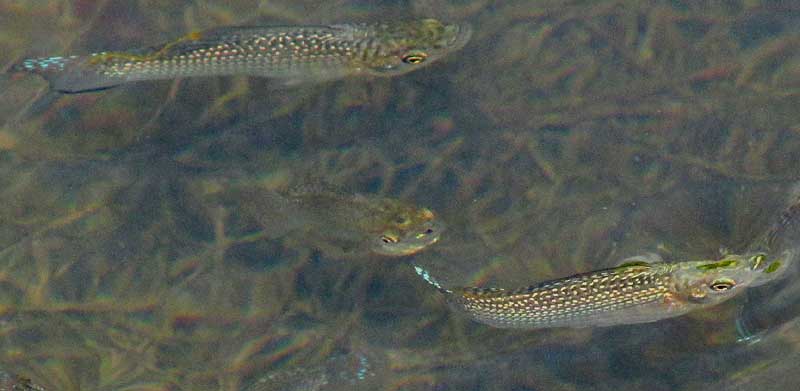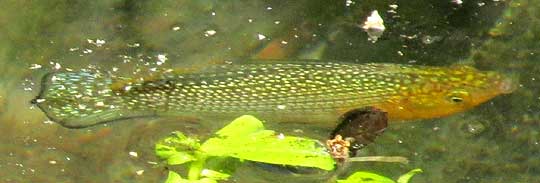Excerpts from Jim Conrad's
Naturalist Newsletter

from the May 31, 2015 Newsletter issued from Río Lagartos, on the Yucatan Peninsula's northern coast (~N21.60°, ~W88.16°), Yucatán state, MÉXICO
YUCATAN MOLLIES
I was watching fish in a shallow pool beside the mangroves where saltwater streamed through a culvert beneath the Malecón. The culvert connects the estuary with the mangroves, and the direction its water flows depends on what the tide is doing. Thousands of tiny, brownish, guppy-like fish swam at the water's surface, often seeming to gulp air, though it was hard to see how the water could be oxygen poor. Within the multitude of tiny, brown fish, from time to time a small flash of powder blue ignited among the pool's sparkles and ripples. It took awhile to pinpoint the powder blue's source, which turned out to be the top part of tail fins of a tiny minority of the little, brown fish, as seen above.
These fish of an obviously different species from all the others were about 1½ inches long (4cm), a little larger than the others. The picture doesn't show enough detail to see the fins well, much less count the number of spines and rays in each fin, which often is needed to properly identify a fish. Therefore, I used a very untechnical identification technique: I Googled images of every fish listed for Ría Lagartos Biosphere Reserve, looking for small species with powder blue spots on their tails, and the kind of tiny, highly ordered speckling displayed by the fish in our pictures.
There was only one such species, one described as living in marshes, lowland streams, swamps, and estuaries just like where these were found. It's POECILIA VELIFERA, the Yucatan Molly, endemic to the Yucatan Peninsula. The EoL.org (Encyclopedia of Life) website's distribution map indicates that the species is found only along the Peninsula's northern coast.
On the Internet, when I searched for other images of Poecilia velifera, the vast majority found looked nothing like our fish. They displayed different colors, including entirely red, yellow and white bodies, and the powder blue spotting of some covered their bodies entirely instead of being restricted to the tops of their tails. Some of their spotting was of other colors than powder blue, plus many pictures showed fish with outrageously tall, splendiferously colored top, or dorsal, fins.
It turns out that Poecilia velifera is a favorite aquarium fish and as such many spectacular forms have been bred, often by hybridizing with other molly species. Aquarists often call forms with oversized dorsal fins Giant Sailfin Mollies. Beyond that, the fish has been introduced into waters of numerous tropical countries, and pictures of them might show forms ranging from the most bizarre to our relatively subdued-looking ones. In the US they turn up, often in large numbers, in coastal wetlands from North Carolina south all along the Gulf of Mexico. Poecilia velifera introduced into California have caused a decline in populations of the federally endangered Desert Pupfish, Cyprinodon macularius.
Much in contrast to that, in Ría Lagartos Estuary, Yucatan Mollies are "specially protected" because of two distinctions: First, they are among the estuary's species most tolerant to the least salty water, and; second, they are listed by Mexico's CONABIO as endemic and threatened.
I read that they can reach six inches in length (15cm) so our fish definitely are juveniles. Sometimes I see adults hanging around the submerged parts of stilt roots of Red Mangrove along the estuary's sides.
Yucatan Mollies eat algae and other plant materials, as well as aquatic invertebrates, including mosquito larvae.
from the June 14, 2015 Newsletter issued from Río Lagartos, on the Yucatan Peninsula's northern coast (~N21.60°, ~W88.16°), Yucatán state, MÉXICO
MORE COLORFUL YUCATAN MOLLIES
Nowadays I'm seeing larger, more colorful fish, the powder-blue spots now covering all their tail fins, the bodies' white spots more vivid, and now their entire front ends are flushed with orange, as seen below:
